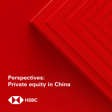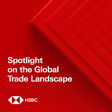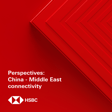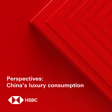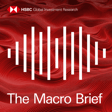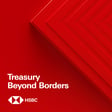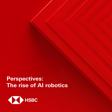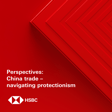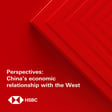Become a Creator today!Start creating today - Share your story with the world!
Start for free
00:00:00
00:00:01

Global Emerging Markets Update
Dr. Murat Ulgen, HSBC’s Global Head of Emerging Markets Research discusses with Chris Brown-Humes how EM is performing across regions and asset classes, delving into the big issues facing EM right now, such as Fed tapering, global growth, inflation and liquidity. This episode was recorded on Wednesday 22 September 2021. Disclaimer.
To stay connected and to access free to view reports and videos from HSBC Global Research please click here.
Hosted on Acast. See acast.com/privacy for more information.
Transcript
Introduction to HSBC's LinkedIn Live Discussion
00:00:00
Speaker
Hello, a very warm welcome indeed to this HSBC Global Research LinkedIn Live discussion on emerging markets.
00:00:30
Speaker
My name is Chris Brown-Hulmes, I'm the managing editor here at Global Research and I'm delighted to be joined today by Dr. Murat Ulgan, our global head of emerging market research.
00:00:39
Speaker
Now in the next half hour, Morat will be sharing his key insights on emerging markets.
00:00:44
Speaker
I'm going to set the ball rolling.
00:00:46
Speaker
Morat, I think it'd be great to start with a bit of context here.
Performance Challenges in Emerging Markets
00:00:50
Speaker
Can you just tell us how emerging market assets have performed so far this year and relative to developed markets and bring us right up to date, given that there have been quite a few jitters in markets in the last few days?
00:01:03
Speaker
Yes, thank you very much, Chris, and hello everyone.
00:01:05
Speaker
Indeed, it's been quite a volatile summer.
00:01:08
Speaker
Actually, since the beginning of the year, the risk sentiment has seen a
00:01:11
Speaker
rollercoaster ride, we've seen large swings in financial markets.
00:01:15
Speaker
And when you look at the EM asset classes, their performances year to date, they're close to or even below zero.
00:01:22
Speaker
And as it was a big underperformance compared to EM, compared to developed market equities.
00:01:27
Speaker
And it's understandable because, you know, when you look at the external backdrop, there are so many moving parts and so many uncertainties, financial markets in general and emerging markets in particular, they have to content with
00:01:40
Speaker
Continued COVID-19 headwinds, the downside risk to the global economy, uncertainty surrounding inflation, an impending Fed tapering of asset purchases and a resurgent dollar.
00:01:51
Speaker
And as you said recently, the headlines coming out of the Chinese property development sector
00:01:57
Speaker
They haven't been helpful either, even though things are calming down a little bit.
00:02:00
Speaker
So too many moving parts, a lot of uncertainties.
00:02:03
Speaker
And it doesn't look like any of these will go away anytime soon in the remainder of the year or going into 2022.
Global Growth and Inflation Challenges
00:02:09
Speaker
So understandably, it's been quite volatile and not great performance, somewhat disappointing performance, I have to say.
00:02:14
Speaker
Thank you.
00:02:16
Speaker
Well, you're right on the topic here because we did have a poll in the run up to this about the challenges facing emerging markets for the rest of the year.
00:02:24
Speaker
We gave the audience four options.
00:02:26
Speaker
One was Fed tapering, another inflation, another slower global growth, and the final one a stronger dollar.
00:02:33
Speaker
Now, top of the poll by a short margin over inflation was slower global growth.
00:02:39
Speaker
Do you see that as the main challenge for emerging markets?
00:02:42
Speaker
It is a big challenge because when you look at the emerging markets and how they drive flows, capital flows, portfolio flows, and how returns are correlated, emerging markets are known to be higher growth in the economy.
00:02:57
Speaker
So growth is very important, very correlated with those.
00:03:00
Speaker
When growth is under pressure or there are downside risk or loss of momentum, that inevitably impacts flows and returns.
00:03:07
Speaker
As a matter of fact, we posted on LinkedIn previously
00:03:12
Speaker
what we call a global growth factor, when we look at the market's pricing of global growth outlook from financial market parameters almost on a daily basis.
00:03:21
Speaker
It's a volatile series, but it tells us a story there, and it's actually very well correlated with other indices, other global growth trackers that use some monthly macro parameters.
00:03:31
Speaker
I think the story here or the message is somewhere around at the end of the second quarter of this year,
00:03:37
Speaker
Global growth momentum has peaked and ever since then it's been slowing down and this is impacting emerging markets as well.
00:03:43
Speaker
That's obviously because of COVID and obviously because of the Delta variant.
00:03:47
Speaker
It is a bigger issue in Asia, but in other parts of the world as well.
00:03:51
Speaker
And all the associated continued restrictions in certain places, maybe not that much in the West, but the numbers are elevated there too.
00:03:59
Speaker
So that clearly causes downside risk to the global growth outlook or loss of momentum deceleration.
00:04:05
Speaker
And that impacts EM activity, EM performance and EM outlook.
00:04:08
Speaker
So understandably, it is perceived to be a big risk in the remainder of this year.
00:04:13
Speaker
But clearly inflation is also perceived to be a big risk.
00:04:16
Speaker
I mean, how worried are you about that?
00:04:19
Speaker
That's actually very interesting.
00:04:20
Speaker
I mean, if you look at the poll results, you know, people are worried about slower growth and higher inflation.
00:04:24
Speaker
That is not a great combination.
00:04:27
Speaker
I mean, inflation has been on an uptick across emerging markets, you know, just to put things into numbers since the beginning of the year, it's gone up from about 2% to about 4%.
00:04:37
Speaker
If you exclude China, actually, it's more like from 4.5% to 6.5%.
00:04:41
Speaker
And core inflation has been on the rise as well.
00:04:44
Speaker
And no wonder, you know,
00:04:46
Speaker
Some emerging market countries are actually hiking rates and some are quite aggressive, not in Asia, but clearly in Latin America and parts of EMEA.
00:04:54
Speaker
So there is a worry about inflation.
Stagflation Risks and Fed Tapering Concerns
00:04:55
Speaker
Although when we looked at inflation in more detail, with a few exceptions, it does appear to be mostly a cost side issue that is stemming from the earlier rise in commodity prices stemming from
00:05:08
Speaker
Supply chain disruptions and all the prices that are going up for raw materials, for semi-finished goods, finished goods, it's actually a downside growth risk as well because it's supply shock.
00:05:19
Speaker
So the supply chain disruptions are featuring in downside growth risk and also in higher inflation risk.
00:05:25
Speaker
But it's mostly a cost issue.
00:05:27
Speaker
Although different regions are showing different dynamics and trends in terms of passing these cost pressures,
00:05:34
Speaker
into end user inflation.
00:05:35
Speaker
It's quite interesting actually broadly speaking in Yemen, Asia and parts of EMEA, these cost pressures are not passed on to end user inflation that much, whereas in Latin America they are actually passed and spilled over to end user inflation and you know CPI inflation and it's no wonder that Latin American centimax have been the most aggressive in monetary policy tightening.
00:05:55
Speaker
Yeah so one of our audience is asking here do you see stagflationary risks picking up going into 2022?
00:06:02
Speaker
Well, I mean, to me, stock relation is a bit of a definitional issue.
00:06:06
Speaker
I think it depends on how much growth slowdown and inflation rise you're factoring in.
00:06:11
Speaker
But let's put it this way.
00:06:13
Speaker
It is a deterioration of growth inflation tradeoff.
00:06:16
Speaker
You unfortunately get subdued growth outlook and still inflation issues.
00:06:20
Speaker
But again, I go back to my earlier point.
00:06:23
Speaker
Inflation to us, broadly speaking, generally speaking, is a cost side issue and it will subside.
00:06:29
Speaker
So admittedly, this is a little bit more prolonged and protracted than we had originally thought, but we still believe this is mostly a cost side issue and demand side inflation pressures are still broadly absent and the labor markets still have a big slack.
00:06:43
Speaker
How big a concern is Fed tapering going to be for emerging markets?
00:06:49
Speaker
It's a big deal.
00:06:50
Speaker
We've looked at it under the sort of concept of global liquidity, the backdrop of global liquidity.
00:06:58
Speaker
And actually throughout the summer, a few things have happened.
00:07:01
Speaker
one of which was posted for emerging markets, which was the SDR injection by the IMF.
00:07:06
Speaker
It's the special drawing right.
00:07:08
Speaker
It's a unit of international currency.
00:07:10
Speaker
It's the unified account for the IMF.
00:07:13
Speaker
And IMF has actually conducted its biggest SDR injection to member countries, $650 billion, because in history, an EM received $275 billion, a little bit less than 1% of EM GDP.
00:07:24
Speaker
So that is a posted on global liquidity.
00:07:26
Speaker
But what is negative,
00:07:27
Speaker
is clearly where the tapering comes into the equation.
00:07:30
Speaker
But even before tapering, we have looked at the changes in global liquidity.
00:07:35
Speaker
It's annual change, the growth rate, the first derivative.
00:07:38
Speaker
Pretty much since the end of the first quarter of this year, global liquidity growth is actually coming lower.
00:07:44
Speaker
Now, don't get me wrong.
00:07:45
Speaker
Global liquidity is still plentiful, it's still ample, and it's still growing.
00:07:48
Speaker
But it's growing at a much, much slower pace compared to what it was late last year and early this year.
00:07:54
Speaker
And this has implication on IAM fund flows with a lag.
00:07:57
Speaker
we have established correlations and it takes up to three to four quarters of a lag
00:08:01
Speaker
the changes in global liquidity, they spill over and impact E&M fund flows.
00:08:06
Speaker
Now, tapering comes into the equation right here because tapering, when it starts, how it will be conducted, at what clip every month, how much the Fed will reduce treasury purchases or asset-backed security purchases, and when it will end, the intensity magnitude, they will all dictate the future path of global liquidity growth and with a lack E&M fund flows.
00:08:27
Speaker
That's why it's so critical for emerging markets.
00:08:30
Speaker
Yeah, but the last time we had tapering, which was back in 2013, at the end of the global financial crisis, emerging markets were really thrown into a bit of a panic, that so-called taper tantrum.
00:08:42
Speaker
Do you expect anything like that to happen this time around?
00:08:46
Speaker
Chris, it's too early to say this is going to be a tantrum less taper.
00:08:50
Speaker
But there are some areas where you can think that the risks are reduced.
00:08:55
Speaker
For one thing, emerging market countries are already hiking interest rates and increasing their risk premium.
00:09:00
Speaker
As a matter of fact, when you look at what is priced into the markets, the monetary policy out to go across EM, again, it shows regional differences, but broadly speaking, is almost at par the hopelessness.
00:09:11
Speaker
as in 2018.
00:09:11
Speaker
And 2018 was the year when the Fed was actually hiking interest rates.
00:09:15
Speaker
Not only hiking, but hiking more than forecast.
00:09:18
Speaker
At the moment, they're not hiking.
00:09:19
Speaker
They're not even starting tapering yet, whereas emerging markets are increasing interest rates in certain cases pretty aggressively.
00:09:25
Speaker
I take this as kind of a preparation on the EM side, on the risk premium, trying to preempt a repeat of taper tantrum, as you said.
00:09:33
Speaker
So that's one thing.
00:09:34
Speaker
The second thing is
00:09:35
Speaker
The external balances, they're in a much, much better shape.
00:09:38
Speaker
And really, however you slice and dice, whatever you look at, you look at high yield EM, you look at commodity EM, the external balances are much better compared to the taper tantrum.
00:09:48
Speaker
I mean, remember back then, the countries who were singled out with large current account deficits, large emerging market countries on average, 4.5% of
00:09:57
Speaker
of GDP current account tips.
00:09:58
Speaker
Now we're talking about 1% less, you know, for some current account surplus.
00:10:03
Speaker
I think that picture is vastly different, which means the external funding requirements are not that ample.
00:10:09
Speaker
And as I mentioned, there is this extra modest help coming from the IMF in terms of SDR injection, which is also helping with fiscal and external funding needs.
00:10:18
Speaker
So there are differences that mitigate the risks.
Investor Sentiment and ESG Engagement
00:10:21
Speaker
So is it fair to say that those are the two big positives for emerging markets at the moment, the SDR injection and the stronger external balances?
00:10:28
Speaker
Is there anything else you'd like to point to as supporting factors?
00:10:33
Speaker
I mean, it has been pretty strong inflows into emerging markets before the taper tantrum in 2011, 2012, obviously post-global financial crisis.
00:10:42
Speaker
But also, if you remember, there was Abenomics and quantitative and qualitative easing by Bank of Japan,
00:10:48
Speaker
And this has attracted significant fixed income portfolio flows, carry trade related portfolio flows into emerging markets back then, you know, causing crowded positioning and, you know, currencies have appreciated and they cause current account deficits.
00:11:03
Speaker
And now look, you know, we covered the current account part, but there haven't been those significant carry related flows.
00:11:08
Speaker
Yes, there have been some flows into EM.
00:11:10
Speaker
you know, as sort of, you know, as a lagged impact of increasing global liquidity, but they've been mostly to the equity markets.
00:11:16
Speaker
Year to date, out of $110 billion of inflows into EM, $85 billion plus went into equities.
00:11:23
Speaker
And also on the fixed income side, you know, a big part went to China because it's now, you know, opening up its, you know, bond markets have been included in bond indices, etc.
00:11:31
Speaker
So,
00:11:32
Speaker
In a way, you know, I don't know if this is positive or not, but in comparison to, you know, the sort of, you know, the episode leading up to the taper tantrum in 2013, compared to that, I would say the carry trade related inflows towards emerging markets are a lot less, which, you know, as a corollary, hasn't caused appreciation of the currencies.
00:11:55
Speaker
Now, as I'm sure a lot of our audience will know, research has been doing a sentiment survey, EM sentiment survey since last year.
00:12:02
Speaker
We've now had five editions out.
00:12:04
Speaker
The sixth one will be coming in early November.
00:12:07
Speaker
The last one, Murat, showed that investors were pretty cautious sitting on a lot of cash.
00:12:11
Speaker
What do you think is going to do, what's going to be required for them to start putting that cash to work?
00:12:17
Speaker
Yes, Chris, I'm glad you brought it up.
00:12:19
Speaker
It's actually very interesting.
00:12:21
Speaker
You know, we ask investors their cash positions and nearly half of them have in excess of 5% cash in their portfolios.
00:12:31
Speaker
And that's a lot.
00:12:32
Speaker
You know, in certain cases, it's actually 7, 8, if not 10%.
00:12:35
Speaker
That's really a lot of cash that is underinvested or perhaps waiting for the right opportunity.
00:12:40
Speaker
to invest.
00:12:41
Speaker
And the other interesting thing, actually, you know, that's one question we ask.
00:12:45
Speaker
And the other question we also ask is, how are you intended to change that cash position?
00:12:50
Speaker
Are you intended to put it to work, meaning decreasing it or increasing or keeping broadly the same?
00:12:54
Speaker
And 59% said, we want to keep the cash levels broadly unchanged over the next three months.
00:13:00
Speaker
And that 59 is actually the highest since the survey started.
00:13:03
Speaker
So there is a lot of undecided investors,
00:13:07
Speaker
you know, perhaps hesitating to dip in or dip out, not necessarily being positive or negative about emerging markets, but just, you know, perhaps waiting for the right opportunity.
00:13:15
Speaker
And again, to me, it's totally understandable.
00:13:18
Speaker
The context we have drawn at the beginning of this call, we mentioned about all these challenges.
00:13:22
Speaker
And remember, you know, at the beginning of the summer, the whole sort of global market concept was about
00:13:28
Speaker
FED's Hohkisch tilt and inflation, high inflation numbers in the US and what this would mean about global cost of funding.
00:13:34
Speaker
Very swiftly in the summer, this is changing to COVID-19 delta variant varies and downside risk to global economy.
00:13:39
Speaker
So when, you know, the various changes, concerns change so rapidly from one end of the spectrum to the other, when you gyrate so wildly, it's only natural that people want to sit on cash and expect maybe the global environment to tranquil a little bit, you know, have a better predictability, less fluid, and then put that cash to work.
00:13:58
Speaker
Now, on the back of that, one of our questions is, after several quarters of doing the EM survey, are you seeing some longer term trends emerging?
00:14:06
Speaker
That's an excellent question.
00:14:09
Speaker
We do, and there's probably no surprise that, you know, actually a couple of them, one of which is generally Asia is the most preferred region, although in the latest summer survey, investors have actually reduced their positions a bit.
00:14:23
Speaker
And obviously, we've seen a lot of volatility in Asian Chinese markets over the last few months.
00:14:29
Speaker
But that, you know, that trend is very clear.
00:14:32
Speaker
What is interesting is, you know, the other regions, Latam and EMEA, they keep shifting places.
00:14:37
Speaker
And Middle East as well, we go a little bit more granular.
00:14:39
Speaker
But Asia still remains, by and large, a big area where investors prefer.
00:14:44
Speaker
That is, you know, I have to say, we've only done five surveys.
00:14:46
Speaker
So it's, you know, a bit early to draw some structure, long-term conclusions.
00:14:50
Speaker
But that's one thing.
00:14:51
Speaker
Pretty much in every survey, investors are most sort of, their net position, net sentiment, are mostly positive towards Asia, even though they trimmed a bit in the summer survey.
00:15:03
Speaker
I think more important than this is to me a structural and secular trend, it's the ESG engagement.
00:15:08
Speaker
Pretty much in every quarterly survey, the ESG engagement increases.
00:15:13
Speaker
You know, ESG, environmental, social and governance aspect of investing in EM is becoming a lot more ingrained in investor behavior, in investor outlook.
00:15:22
Speaker
It's not only a developed market issue anymore.
00:15:24
Speaker
It's an emerging market issue.
00:15:26
Speaker
ESG, EM linkages are growing.
Impact of Supply Chain Shifts
00:15:28
Speaker
Every survey, every quarter we ask investors,
00:15:32
Speaker
are you running a portfolio?
00:15:33
Speaker
Do you have any exposure either direct or indirectly?
00:15:36
Speaker
Are you running an ESG portfolio?
00:15:40
Speaker
Do you have any exposure on the ESG side?
00:15:42
Speaker
And every quarter, this is increasing.
00:15:45
Speaker
In the latest survey, nearly half of the investors had an exposure to ESG attributes, running an ESG portfolio, either direct or indirectly.
00:15:52
Speaker
That I can clearly say and see as a long-term secular structure trend.
00:15:59
Speaker
But we have a question here saying, do the growth concerns that we've already just been talking about mean that businesses will actually focus less on ESG?
00:16:08
Speaker
I wouldn't think so.
00:16:09
Speaker
I mean, if anything, you know, we have a fantastic research department looking at all the ESG issues and they're constantly published.
00:16:16
Speaker
I think there is a lot of interconnectedness.
00:16:20
Speaker
There is a lot of interlinkages between the ESG attribute and the growth outlook of countries.
00:16:25
Speaker
I mean, in emerging markets, for instance, energy transition comes to my mind or all the climate challenges.
00:16:30
Speaker
They have implications for the growth outlook, you know, a sustainable growth,
00:16:35
Speaker
growth without generating imbalance of inflation or current account and all the investment and infrastructure needs that will shape growth.
00:16:44
Speaker
I mean, I can give you examples.
00:16:47
Speaker
In Asia, Indonesia is my favorite story and Indonesia has been recipient of massive foreign direct investment over the past few years because it has substantial nickel and cobalt deposits and companies from Asia, from the West, they invest like Greenfield, FDI, foreign direct investment in Indonesia.
00:17:03
Speaker
Why?
00:17:04
Speaker
because of, you know, green revolution, because of electrical vehicles, because in Indonesia they can produce the batteries and that gives boost to the growth outlook.
00:17:12
Speaker
So I wouldn't necessarily say, you know, these are working in opposite direction.
00:17:17
Speaker
And actually, I would say pretty much, you know, focusing on ESG brings you eventually a better predictable and sustainable growth outlook.
00:17:25
Speaker
So they actually reinforce each other rather than impede each other.
00:17:30
Speaker
One question we've got is about potential changes in global supply chains and the sort of trend towards more local production.
00:17:37
Speaker
And the question is, you know, which regions could be the main beneficiary?
00:17:42
Speaker
Yeah, very good question.
00:17:44
Speaker
I would say rejigging of supply chains or the shifts in supply chains, they have been there even before the pandemic.
00:17:51
Speaker
I mean, obviously, we have been dealing with a lot of trade tensions and frictions over the last three, four years.
00:17:59
Speaker
And already this was quite topical, you know, how the supply chains will shift and which countries and which regions would benefit.
00:18:05
Speaker
And the pandemic has brought, you know, another
00:18:09
Speaker
interesting and unexpected dynamic in here where the supply chains have been disrupted, partly broken, especially when it comes to the semiconductors and microchips holding up the automotive production and industry in various parts.
00:18:22
Speaker
Our economists have done very, very good pieces on that, especially out of Asia and also out of London.
00:18:28
Speaker
And at the moment,
00:18:29
Speaker
Their assessment evaluation is this is actually a bigger issue in the West than in emerging markets.
00:18:36
Speaker
And obviously, when I say emerging markets, I should probably specify more Asia as a big manufacturing hub across all emerging markets.
00:18:42
Speaker
So it's a bigger issue in the West, you know, from wherever you look at it.
00:18:46
Speaker
You look at the delivery times being extended, you look at the backlogs.
00:18:50
Speaker
You know, if you look at output, less new orders, it is a much bigger issue in the West compared to Asia.
Currency Dynamics and Economic Output
00:18:58
Speaker
But, you know, clearly it's an issue for global supply chains and production.
00:19:03
Speaker
Are there countries benefit from that?
00:19:05
Speaker
I think there are, you know, those countries who are closer to the demand centers, so to speak, and they are flexible.
00:19:13
Speaker
They can do, you know, in small batches, they can ship pretty quickly.
00:19:16
Speaker
They are benefiting.
00:19:17
Speaker
You know, in Asia, we've been seeing this shift for quite a long time.
00:19:22
Speaker
in favor of Vietnam and Malaysia, for instance.
00:19:24
Speaker
I think in India, Turkey benefits a lot.
00:19:26
Speaker
You know, Turkish export numbers have been pretty strong over the past few months or since the beginning of the year because it's very close to Europe and it can easily ship and flexibly a lot of things where, you know, they are benefiting from some replacements, some shifts out of Asia towards Turkey.
00:19:42
Speaker
And in the U.S., in America, or Latin America, Mexico is a big beneficiary.
00:19:47
Speaker
as you know, US is the big demand center.
00:19:49
Speaker
Clearly, you know, Mexico was already connected a lot to the US with 80% of exports ending up in the US, especially manufactured exports, but with the supply chain disruptions
00:19:59
Speaker
In the aftermath of COVID, they benefited from that, you know, sort of, you know, an extra sort of, you know, additional benefit being drawn out of that.
00:20:09
Speaker
So I think those are the dynamics that are impacting supply chains that could they could be structured, they could be long term.
00:20:15
Speaker
And there are some beneficiaries from each region.
00:20:19
Speaker
We've got a question here on emerging EMFX, which is saying with the global economy losing momentum and the Fed potentially reducing stimulus, what is the longer term outlook for EM currencies?
00:20:34
Speaker
Yeah, I'll talk about longer term, but in the near term, our team is direction looking for a stronger dollar, albeit, you know, modestly stronger dollar going into next year.
00:20:45
Speaker
which obviously has an impact on emerging market effects.
00:20:48
Speaker
I'm actually quite surprised that when we pose this question in the poll, that answer hasn't been picked up that much.
00:20:55
Speaker
I was expecting more people picking that.
00:20:57
Speaker
So maybe there are some divergence of views.
00:21:01
Speaker
I think over the medium to long term, the drivers of EMFX outside of
00:21:06
Speaker
global financial and liquidity conditions, I would say EM's own growth dynamics and EM's productivity dynamics, especially total factor productivity.
00:21:15
Speaker
And that actually is obviously tied into growth dynamics.
00:21:18
Speaker
Higher total factor productivity means sustainable long-term growth without imbalances.
00:21:23
Speaker
So to the extent emerging market countries
00:21:26
Speaker
can actually record sustainable long-term growth and a growth that is actually at premium over developed market growth, they will attract inflows in capital and their currencies tend to appreciate.
00:21:40
Speaker
Unfortunately, over the last three decades, we've only seen
00:21:43
Speaker
total factor productivity coming down, especially the last decade before the pandemic, after the global financial crisis.
00:21:49
Speaker
But there are exceptions.
00:21:50
Speaker
You know, Vietnam is the only country where TFP has gone up.
00:21:53
Speaker
India is the only country where TFP stayed the same, where the rest, they have come down.
00:21:58
Speaker
I think
00:21:59
Speaker
productivity growth and sustainable growth is what is needed for EMFX to perform better, not only in real terms, but also in nominal terms, in an environment of growth challenges, in an environment where the easy parts of globalization change
00:22:15
Speaker
could be behind us for emerging market countries.
00:22:17
Speaker
And if anything, from here onwards, it's up to individual emerging market countries to boost their potential via structural reforms, structural changes to boost their productivity.
00:22:27
Speaker
To me, that would be critical.
00:22:29
Speaker
In the near term, as I said, directionally, we're looking for modestly stronger dollar.
00:22:33
Speaker
So you use the initials TFPs, what's that?
00:22:36
Speaker
Total factor productivity?
00:22:37
Speaker
Total factor productivity,
Commodities and Economic Impacts
00:22:38
Speaker
correct.
00:22:38
Speaker
This is, you know, just to give a bit of a context, it's essentially what you get out of your economies beyond what you put in in terms of labor and capital, the factors to production.
00:22:49
Speaker
This is about your policies.
00:22:50
Speaker
This is about your monetary stability.
00:22:51
Speaker
This is about your, you know, investment environment, you know, privatization, liberalization, all the rules and regulations to essentially boost and support and address the business environment.
00:23:05
Speaker
Let's turn to commodities.
00:23:06
Speaker
Where do you see commodities in the next one to three years and what impact do you expect that to have on inflation and real growth?
00:23:12
Speaker
Yes, so our commodities teams, they've been long saying that this is not a super cycle.
00:23:18
Speaker
And in fact, we've seen some big correction commodity prices very recently, perhaps tying to the issues and headlines coming out of China and China property development sector, especially the iron ore.
00:23:30
Speaker
but also still, they still do look for some modest correction in commodity prices, which, you know, perhaps not necessarily too bad for the commodity producing and exporting economies, because these economies, especially in the EM space, especially in Latin America, they haven't benefited from an earlier substantial and significant increase in commodity prices since the middle of last year.
00:23:55
Speaker
So they haven't benefited much in terms of the gains where you see in terms of trade, in external balance, in trade accounts.
00:24:03
Speaker
So in that sense, some modest correction may not have a big impact either.
00:24:07
Speaker
And obviously, when we talk about commodities, we should talk about not only the demand where we mentioned there are some downside risk, global activities losing a bit of momentum, but there are also some supply realities, especially in oil.
00:24:21
Speaker
There is a very disciplined demand.
00:24:23
Speaker
and tight management of supply by OPEC and OPEC plus, which changes the outlook for oil prices.
00:24:30
Speaker
The outlook for the global economy would have argued weaker oil prices, but then the very disciplined supply management kind of holds up prices.
00:24:37
Speaker
And then the final thing is, I circle back to ESG and this sustainability agenda of all large economies where when you put them under each other, the ambitious targets of going to net zero
00:24:52
Speaker
that would mean significant demand for the green commodities, quote unquote, you know, the likes of copper, nickel, cobalt and others.
00:25:00
Speaker
So there are so many factors and vectors influencing commodity price in the near term, perhaps some weakness.
Conclusion and Participant Acknowledgments
00:25:05
Speaker
But there are some other supply dynamics and long term demand dynamics featuring into that as well.
00:25:10
Speaker
Morat, it's been a fascinating discussion.
00:25:12
Speaker
Thanks very much for your time and your insights today.
00:25:15
Speaker
Thanks very much indeed to everyone who's joined the call and for some excellent questions.
00:25:19
Speaker
Thank you all very much.
00:25:21
Speaker
Thank you.
00:25:25
Speaker
Thank you for listening today.
00:25:26
Speaker
This has been HSBC Global Viewpoint Banking and Markets.
00:25:31
Speaker
For more information about anything you heard in this podcast or to learn about HSBC's global services and offerings, please visit gbm.hsbc.com.
